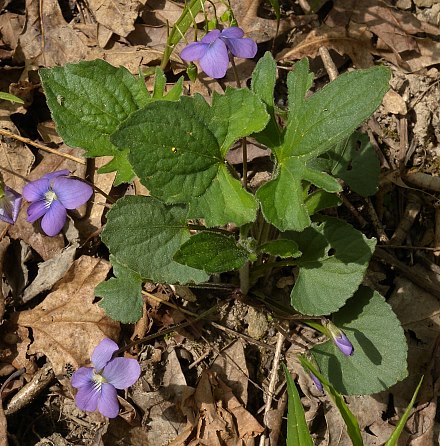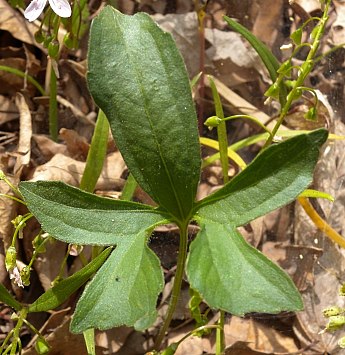Description: This perennial wildflower consists of a rosette of low basal leaves about 4-7" across, from which several flowering stalks develop. The blades of the basal leaves are 1½-3" long and similarly across; in outline, they are oval, orbicular, or orbicular-reniform. Early leaf blades usually lack lobes, while later blades have 3-5 major lobes and sometimes smaller secondary lobes. These palmate lobes are irregular in shape and they usually extend up to one-half of the distance, and sometimes even more, into the interior of a blade. The margins of early leaf blades are finely crenate, while the margins of later blades are smooth, crenate, or dentate. Upper surfaces of the leaf blades are medium to dark green and hairless (or nearly so), while their lower surfaces are light green and usually hairy along the major veins. The petioles of the basal leaves are relatively stout and long (about 2-4" in length), light green to pale purplish green, and either smooth or hairy.

Individual
flowers develop from ascending pedicels; the flowers are usually held
above or beyond the leaves. The pedicels are either smooth or hairy.
Each flower is about ¾-1" across, consisting of 5 spreading blue-violet
petals, 5 light green linear-lanceolate sepals, 5 inserted stamens, and
a pistil with a single style. The two lateral petals have small tufts
of white hairs at their bases, while the bottom petal has several
violet veins on a white background that function as guides to the short
nectar spur in the back of the flower. These flowers bloom during mid-
to late spring for about 3 weeks. Later during the summer,
inconspicuous cleistogamous flowers are produced on short pedicels;
these flowers are self-fertile. The flowers are replaced by
ovoid-oblong seed capsules that split open into 3 sections, ejecting
their seeds. The small seeds are globoid and brown. The root system
consists of a vertical crown with fibrous roots. This wildflower
spreads by reseeding itself.
Cultivation:
The preference is partial sun, mesic to dry conditions, and soil that
is loamy or rocky. This violet is relatively intolerant of heavy leaf
litter and competition from taller ground vegetation.

Range &
Habitat:
Three-Lobed Violet is a native wildflower that is occasional in the
southern half of Illinois, becoming uncommon or absent in the northern
half of the state (see Distribution
Map). Habitats consist of upland woodlands, rocky open
woodlands, wooded slopes, riverbanks, and thinly wooded bluffs. In
these habitats, oaks are often dominant as canopy trees. Three-Lobed
Violet is usually found in higher quality woodlands where the original
ground flora is still intact.
Faunal Associations:
The flowers are usually pollinated by bees, including Mason bees (Osmia
spp.) and Andrenid bees. One bee species, Andrena
violae, is a specialist pollinator of violets. Occasionally,
butterflies and ants visit the flowers for nectar; the latter are
ineffective at cross-pollination. The foliage and flowers of violets
are eaten by several kinds of insects. These insect feeders include the
caterpillars of several Fritillary butterflies (Boloria spp.,
Speyeria spp., & Euptoieta
claudia), the caterpillars of the moths Elaphria
grata (Grateful Midget) and Eubatha mendica
(The Beggar), the thrips Odontothrips pictipennis,
the larvae of Ametastegia pallipes (Violet Sawfly),
and Neotoxoptera violate (Violet Aphid). The seeds
are coated with a substance that is attractive to ants, which help to
disperse the seeds into new areas. Violets are a minor source of food
to some vertebrate animals. For example, the Wood Turtle (Clemmys
insculpta), Eastern Chipmunk, and White-Tailed Deer sometimes
eat the foliage, while the Mourning Dove and possibly other birds eat
the seeds.
Photographic Location:
Along a path on a wooded hill in Lakeview Park near Charleston,
Illinois.

Comments: The most unusual characteristic of this violet is the highly variable shape of its leaf blades. Three-Lobed Violet has been considered a separate species in the past (known as Viola triloba), but it is now classified as the typical variety of Viola palmata. It differs from another variety, Viola palmata dilatata, by having leaf blades with either fewer lobes (3-5) or no lobes. The latter variety, referred to here as the Cleft Violet, has leaf blades with 5-9 lobes and it never produces leaves without lobes. Both varieties occupy similar habitats, although the Cleft Violet may prefer habitats that are more rocky and barren.